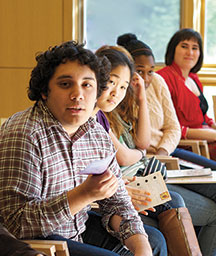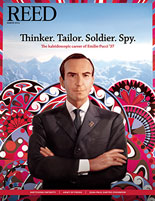
IRIS login | Reed College home Volume 93, No. 1: March 2014
Saving Starfish

Kate Jentoft-Herr ’16 with her RELAY coach Louis Cohen, education program leader of Friends of the Children.
Photo by Matt D'Annunzio
Reed Leadership Academy (RELAY) trains students in the art of collaboration.
By Randall S. Barton
What makes a leader? Is it boundless charisma, unshakeable confidence, raw power? Is leadership innate or acquired?
“There may be some leadership qualities that people are born with, but much of it is skills you’ve learned and practiced,” answers Prof. Kathryn Oleson [psychology 1995–]. “A leader is someone who finds opportunities where something needs to be done and is able to fill in those gaps.”
Prof. Oleson helped launch the Reed Leadership Academy (RELAY), a new initiative which trains Reed students in the art of leadership and creative collaboration. RELAY students attend weekly classes (without credit), participate in a service project, and pair up with coaches from the community at large.
The origins of RELAY lay in a chance conversation between Kristin Holmberg, director of student activities, and Prof. Crystal Williams [English 2000–13] (then dean of institutional diversity, now chief diversity officer at Bates College), when Williams mentioned that she was thinking about starting a leadership program for students of color.
“I’ve been thinking about starting a leadership program for everyone,” Holmberg replied, and the two began exploring the idea together.
The program is based on the social change model of leadership development and combines introspection, theory, discussion, and a service project, where students apply the skills they have acquired.
“The social change model of leadership is about collaboration, not about someone telling other people what to do,” explains RELAY coach Mariann Hyland, director of diversity and inclusion for the Oregon State Bar. “It’s about establishing a common purpose. There are many different leadership styles and some schools of thought that are more top-down. But in the organizations I’ve worked in, the top-down style is not very effective.”
Hyland says the most important attribute leaders can have is an understanding of what makes them tick, because their issues and personal biases influence how they interact with and perceive others.
“You can work through just about any conflict if you have that consciousness of self,” she says. “Recognizing your weaknesses, and being able to speak to them candidly, will help you value the strengths that other people bring to the table and get the work accomplished.”
In RELAY, students compose a personal definition of leadership; identify the values that are most important to them; and examine their own identities and cultures in relation to their practice of leadership.
“We wanted to broaden the idea of leadership, because it means being able to interact with people from diverse backgrounds,” Oleson says. “You’ve got to learn how to work in groups. It’s a skill that you’ll use forever, and you can teach those skills.”
Esmeralda Herrera ’14, a linguistics major from New York, says students spent a lot of time thinking about leadership as a process. Instead of just bossing people around, a true leader can help mediate a conflict in the group or encourage others who lack confidence.
“We focused on being considerate of each others’ complex identities,” she says, “because the surface things one might observe do not really equal the identity someone has. Leadership is a process, and it’s not just you; it’s a group thing.”
Guest speakers addressed the ethical choices leaders are sometimes called upon to make. A police officer told about arresting someone who is mentally ill and weighing the pros and cons of taking him to a mental hospital versus returning him home. Dr. Jonathan Jui, a doctor at Oregon Health & Science University, was in New Orleans after Hurricane Katrina and told of making life-and-death decisions about whom to treat because of limited medical supplies.
Of course, leaders are influential, but group leader Santi Alston, assistant dean of students, says that the definition of influence varies.
“We want students to be doing work that aligns with their core values,” he says. “That is what real leadership looks like.”
RELAY coach Caitlin Baggott ’99 is the program founder of PolitiCorps, a leadership “boot camp” for college grads interested in hands-on politics and social change. “When I work with young people I talk about team leadership,” she says. “We work on developing skills to be an effective part of the team, moving away from the idea that leadership is something an individual holds, instead of something a community holds.”
Several students were struck by the diversity of the RELAY classes. “Everyone came from a different background with a different story,” says Kate Jentoft-Herr ’16, an environmental chemistry major from Washington, D.C. “One of our first activities was to write down a stereotype about a group we belong to and talk about that. It was interesting to see how people identified themselves and to see the vast array of different identifications.”
During one class, participants were asked to stand in different corners of the room based on how they dealt with conflict.
“It was cool to actually see how all these people reacted to conflict in different ways,” says Kate. “Everybody had a different idea of how they’d respond.”
Kate’s coach was Louis Cohen, education program leader of Friends of the Children, who sharpened her job-seeking skills by conducting mock interviews. The skills she acquired at RELAY gave her a new perspective on the leaders at a performing arts camp for kids, where she has worked the last four summers.
“This year, for the first time, I was able to look at the camp leaders and see what they were doing well and what they were doing badly,” she says. “Things that had always been a mystery to me became very evident.”
Marina Moro ’16, a political science major from Gilroy, California, recalls a thought experiment the students discussed.
“I’m on a beach and see all these starfish washed up on the shore,” she says. “I start throwing them back one by one and someone comes up and says, ‘Hey, there’s so many starfish, you can’t possibly make a difference.’ And I say, ‘It’ll make a difference to this one.’”


LATEST COMMENTS
steve-jobs-1976 I knew Steve Jobs when he was on the second floor of Quincy. (Fall...
Utnapishtim - 2 weeks ago
Prof. Mason Drukman [political science 1964–70] This is gold, pure gold. God bless, Prof. Drukman.
puredog - 1 month ago
virginia-davis-1965 Such a good friend & compatriot in the day of Satyricon...
czarchasm - 4 months ago
John Peara Baba 1990 John died of a broken heart from losing his mom and then his...
kodachrome - 7 months ago
Carol Sawyer 1962 Who wrote this obit? I'm writing something about Carol Sawyer...
MsLaurie Pepper - 8 months ago
William W. Wissman MAT 1969 ...and THREE sisters. Sabra, the oldest, Mary, the middle, and...
riclf - 10 months ago